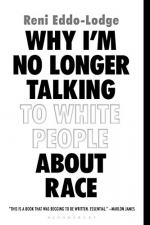
|
| Name: _________________________ | Period: ___________________ |
This test consists of 15 multiple choice questions and 5 short answer questions.
Multiple Choice Questions
1. How does the mixed-race "Jessica" choose to identify in terms of racial background?
(a) White.
(b) Indian.
(c) Hispanic.
(d) Black.
2. Why did Eddo-Lodge ask her mother at age 4 when she was going to "turn white"?
(a) Her favorite story was about a girl whose skin color changed one day.
(b) She had already noticed that the vast majority of positive portrayals of characters on television were white.
(c) A friend had told her she would turn white someday.
(d) She had noticed her skin starting to change appearance.
3. What city did Martin Luther King Jr. write a famous letter from a jail cell in in 1963?
(a) Atlanta, Georgia.
(b) Jackson, Mississippi.
(c) Little Rock, Arkansas.
(d) Birmingham, Alabama.
4. Who was the judge who served the sentence in the murder trial of Stephen Lawrence?
(a) Judge Mr. Justice Windham.
(b) Judge Mr. Justice Windsor.
(c) Judge Mr. Justice Eton.
(d) Judge Mr. Justice Treacy.
5. What legal requirement in the U.K. adoption process did David Cameron remove in 2012?
(a) For adoptions to only be allowed to married, heterosexual couples.
(b) For prospective parents to have a certain income threshold.
(c) For adoptions to only be allowed to parents living in major U.K. cities.
(d) For local authorities to consider a child's racial, cultural and linguistic background during the adoption process.
6. Which white nationalist party was formed in Britain in 1967?
(a) The Starwalt Front.
(b) The Back to Front.
(c) The National Front.
(d) The Supreme Front.
7. Which ethnic group of people in the U.K. are the most at risk to be admitted to psychiatric hospitals under the compulsory powers of the Mental Health Act, according to a 2003 NHS England report?
(a) White people.
(b) African and African Caribbean people.
(c) Indian people.
(d) Asian people.
8. What kind of group or place do some people seek to be able to talk about living under the weight of racism with like-minded people?
(a) A roundtable.
(b) A university debate.
(c) A church discussion.
(d) A safe space.
9. In 1982, where did John Fernandes work?
(a) Oxford University.
(b) Herrod's Department Store.
(c) Kilburn Polytechnic.
(d) The Brixton Police Department.
10. What important abolitionist group was established in the year 1787 in Britain?
(a) The Society of Abolitionists in Britain.
(b) The Gettysburg Group.
(c) The Emancipation Group.
(d) The Society for Effecting the Abolition of the Slave Trade.
11. Which transportation company did Guy Bailey interview with in 1965?
(a) The Brixton Bus Company.
(b) British Rail and Road.
(c) The Marshall Organization.
(d) Bristol Omnibus Company.
12. When did Eddo-Lodge begin to think about Black British history?
(a) When she was about 10 years old.
(b) After her college graduation.
(c) When she was about 15 years old.
(d) Her second year of university.
13. Which city had been the site of Britain's largest slave port?
(a) Blackpool.
(b) Liverpool.
(c) London.
(d) Hartfordshire.
14. What prompted the Brixton riots in 1981?
(a) The police force's Operation Swamp.
(b) The police beating of an unarmed Black man.
(c) The police beating of a young Black woman.
(d) The police shooting of Douglas Rabar.
15. Who was shot by the police in her own home and subsequently paralyzed by her injury?
(a) Cherry Groce.
(b) Patrician Windham.
(c) Marcella Wynne.
(d) Imelda Kerry.
Short Answer Questions
1. What was Britain's first race-relations act, The Race Relations Act, passed?
2. Where was Jessican's father originally from?
3. What organization did Dr. Harold Moody form in 1931 in England?
4. When did Britain begin trading in African slaves?
5. A 2009 report from the Equalities and Human Rights Commission found that what percentage of all Black men living in Britain were on the National DNA Database?
|
This section contains 565 words (approx. 2 pages at 300 words per page) |

|




